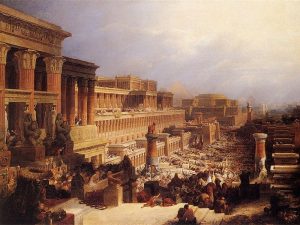
Dr. Hector Avalos has posted at Debunking Christianity his thoughts on the documentary film, Patterns of Evidence: Exodus produced by Timothy Mahoney, and reasons to discount the historicity of the Exodus. Film trailer.
I posted various views of the origins of the Exodus story in a number of posts now.
So speaking of Exodus, here I want to continue on from a 2014 post, Transvalued Folktales & Classifying the Bible’s Narratives, and see how a contemporary specialist in Exodus identifies the signs of folklore or fairy tale in this biblical narrative.
William H.C. Propp sees in the Exodus tale the same nuggets that go into the making of folktales or fairy tales and that were set out by another Propp (no relation), Vladimir Propp in 1968, The Morphology of the Folk Tale. For an outline of these structural elements see the Wikipedia article on Vladimir Propp. William Propp’s argument is found in his commentary, Exodus 1-18: a new translation with introduction and commentary, pp. 32 to 34
William Propp begins by acknowledging that Exodus is far more complex than the ordinary folktale. For a start Exodus has not one but three heroes: God, Moses and Israel. Other tale types intrude as well. Nonetheless, “the overall sequence of events follows [Vladimir] Propp closely.”
(I have added Propp’s symbol for each function — e.g. β, H, ↓, Pr
| Propp function | Exodus |
| 1. Initial situation (e.g. family members introduced) — α | 1:1-5 — the Genealogy of Israel |
| 2. Family member is absent (there is a change in the normal situation) — β | 1:6 — the Passing of Joseph’s generation |
| 3. The villain harms a family member — A | 1:11-14 — Israel is enslaved |
| “At this point several extraneous tales interrupt the Proppian flow: the mid-wives story (1:15-21), Moses’ birth (1:22-2:10), his excursion outside the palace (2:11-15a) and his Midianite sojourn (2:15b-22). These are independent tale types: the Hoodwinked Villain, the Floating Foundling, the Disillusioned Prince, the Sojourner’s Tale. The last three take Moses into the desert, where we rejoin the Proppian sequence.” (p. 33) |
| 4. The misfortune is made known and responded to — B | 2:23b-25 — Yahweh takes note of Israel’s oppression and resolves to act. |
| 5. The Hero is tested or interrogated and given a task by the Donor-Helper, whom he encounters accidentally — D | 3-4 — The Burning Bush |
| 6. The Hero is given a magic agent — F | 4:17 — Moses receives the divine staff and various miracles |
| 7. The Hero is relocated to the vicinity of the Sought-for Person — G | 4:18-23 — Moses returns to Egypt at God’s command to rescue Israel |
| 8. The Hero is branded (e.g. given a protective mark by a princess) — J | 4:24-26 — Hero Moses and the Bloody Bridegroom episode |
| 9. The Hero and Villain fight (sometimes repeatedly) — H | 5:1-12:42 — the contest between Moses and Pharaoh and the plagues |
| 10. The Hero is branded (e.g. given a protective mark by a princess) — J | 12:1-28 — towards the end of the contest, the Israelites’ homes receive the mark of the blood (another symbolic wound) on their doorposts that will save them. |
| 11. The Villain is defeated — I | 12:29-30 — Pharaoh is defeated when his first born son is killed. |
| 12. The initial misfortune or lack is removed (e.g. a captive is freed) — K | 12:31-42 — Israel is freed. |
| 13. The Hero returns/flees homeward — ↓ | 12:30-42; 13:17-22 — Moses and Israel leave Egypt |
| 14. The Hero is pursued — Pr | 14:2-10 — Pharaoh mobilizes his army and pursues Israel |
| 15. The Hero is rescued — Rs | 14:15-15:21 — The Sea parts and Israel marches through. |
The narrative departs from the neat Proppian structure at this point but nonetheless there remain several similarities that may be disguised but not easily dismissed.
| Sometimes on returning home a Hero is assigned a difficult task — Function M | 15:23-17:16 — Yahweh regularly tests Israel and this is a dominant theme of the narrative. |
| The Hero passes an ordeal — Function N | In the Midrash God offers the Torah to other nations but they all fail the test and decline the offer. Only Israel succeeds in accepting it. |
| The Hero then turns on his rivals who tried to destroy him and defeats them — Function Ex | 17:8-18:27 — Israel destroys the Amalekites and Midianites. |
| The Hero then experiences a change of status — Function T | 19:6 — Israel is transformed into a “priestly kingdom” |
| The Hero next marries a princess and ascends a throne — Function W | 19-20 — Israel is bound forever to God by a Covenant — note that in the Bible a Covenant is often said to be a marriage. Yahweh and Israel are in a sense married. |
If you enjoyed this post, please consider donating to Vridar. Thanks!

Probably Propp needs someone to write a neater follow up. Still, it’s always nice to hear from Propp. One of the founders of Structuralism.
It boggles the mind that people are gullible and superstitious enough to believe these events actually happened.
Depends on the events in question. Religious preaching and even faith-healing are not rare events. The extent of historical and geographical gullibility about their supernatural origin is well illustrated by Craig Keener’s substantial 2-volume study of “Miracles”. Bill Darlison’s book on the Gospel Zodiac doubts the historicity of Jesus while supporting the credibility of personal horoscopes – there is no end to illustrations of that well-known remark about belief attributed to Chesterton.